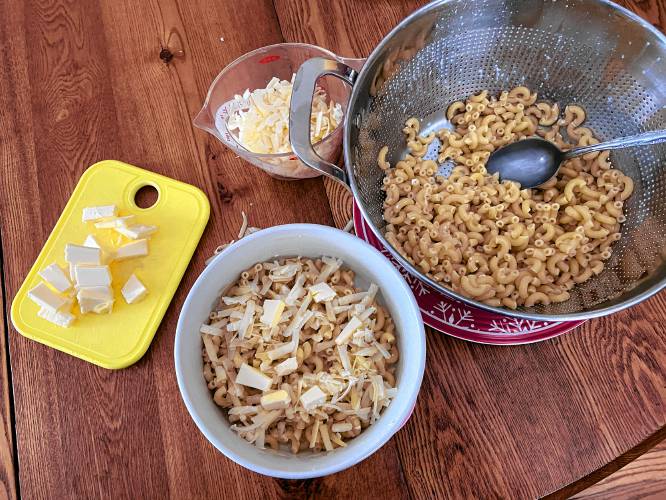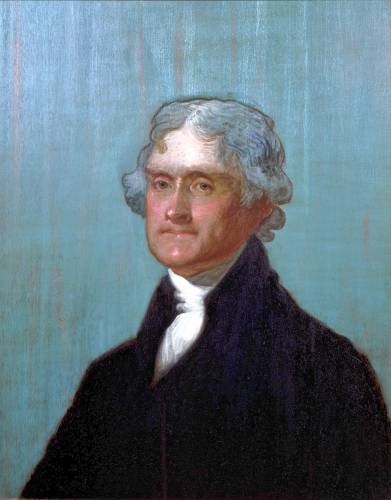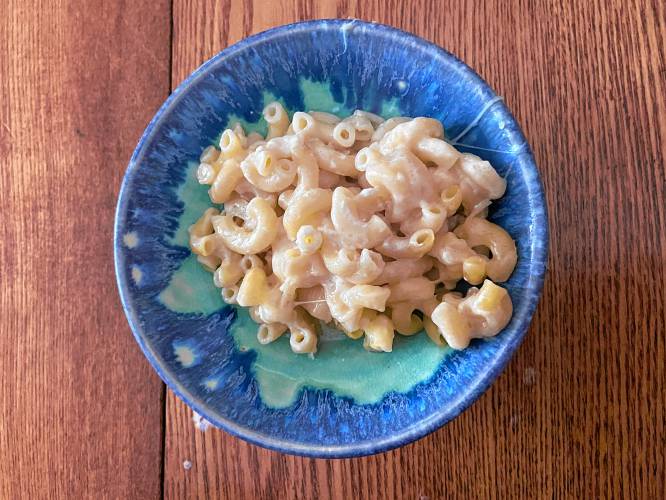Remembering a pioneering Black chef: James Hemings, Jefferson’s enslaved personal chef and half brother-in-law, was first American to become a French chef de cuisine
| Published: 02-24-2025 1:01 PM |
For Black History Month, I’m making Macaroni Pie.
This recipe, and its creator, show the ways in which food history is history in general. Now known as macaroni and cheese (although made slightly differently), the dish was first prepared in this country by James Hemings (1765-1801), Thomas Jefferson’s enslaved personal chef and half brother-in-law.
American history abounds with difficult but inescapable facts. One of the hardest facts to grasp is that many of our Founding Fathers, whose opinions are enshrined in our government, enslaved other people. Jefferson is particularly difficult because he spoke and wrote so eloquently of the rights of human beings.
He called slavery “a moral and political depravity” and argued that it should be eliminated. As a young lawyer, he represented enslaved people suing for their freedom. Nevertheless, he was unwilling to sacrifice his comfort and that of his family by freeing the 600 enslaved people who worked on his property.
His relationship with the Hemings family is particularly challenging to historians. The enslaved Elizabeth “Betty” Hemings and her 10 children came to live in the statesman’s home in Virginia when Jefferson’s father-in-law, John Wayles, died.
Wayles had fathered half of Betty’s children, including James, as well as Jefferson’s future inamorata, Sally. Their “ownership” was transferred to Wayles’s daughter, Martha Jefferson, who was a half-sister to James and Sally.
Husbands had total sway over their wives’ property in the 18th century so Betty Hemings and her children came under the control of Martha’s husband, Thomas Jefferson.
James Hemings was only 8 or 9 when he arrived at Jefferson’s home, Monticello. The boy started work as a valet. In 1784, Jefferson took the teenager to Paris, where Jefferson served as our new nation’s minister to France.
Article continues after...
Yesterday's Most Read Articles
 Athol man to serve five to seven years on child abuse charges
Athol man to serve five to seven years on child abuse charges
 Northfield man dies in Erving motorcycle crash; Bernardston man injured in Deerfield crash
Northfield man dies in Erving motorcycle crash; Bernardston man injured in Deerfield crash
 Rafters rescued from Deerfield River in Charlemont
Rafters rescued from Deerfield River in Charlemont
 No injuries from school bus, recycling truck collision in Gill
No injuries from school bus, recycling truck collision in Gill
 Nationwide, beekeepers report loss of 1.6M colonies in 10 months
Nationwide, beekeepers report loss of 1.6M colonies in 10 months
 Conway barn destroyed in blaze likely caused by lightning strike
Conway barn destroyed in blaze likely caused by lightning strike
Jefferson appreciated good food and knew how it could smooth a diplomatic mission. He therefore sent young James Hemings to culinary school in Paris, making Hemings the first American to become a French chef de cuisine.
When, after five years in Paris, the future president and his entourage returned to Monticello, Hemings brought French foods and techniques to the Jefferson home. Among the dishes he imported were Chantilly (whipped cream), meringues, French fries, ice cream, and crèmebrulée.
Hemings went on to cook at many state dinners, both at Monticello and in Philadelphia, an early seat of the U.S. government. He was in Philadelphia at the same time as one of our country’s other early celebrity chefs, George Washington’s enslaved cook Hercules.
Ironically, James Hemings could have become free if he had consulted the authorities in Paris or followed the law in Philadelphia. In the latter city, enslaved people who stayed at least six months were automatically freed. (Some slave holders, including Washington, made sure that this couldn’t happen by sending their “property” home from Philadelphia briefly every few months.)
Hemings, who was well educated (he could read and write in both English and French), asked Jefferson to free him in Philadelphia. Jefferson assented, with conditions.
Noting that he had made a considerable investment in Hemings’s culinary education, Jefferson pledged that he would free the young man after Hemings went back to Monticello and taught his techniques to another cook. That cook turned out to be Hemings’s brother Peter.
James Hemings was freed and left Monticello in 1796. He moved first to Philadelphia and then to Baltimore, where he died young in 1801, not too long after Jefferson was elected president.
Jefferson hoped Hemings would cook for him at the White House. Chef Ashbell McElveen, the founder of the James Hemings Society, believes that Hemings would have done so … if Jefferson had asked him politely in a letter.
Instead, according to McElveen, the president summoned Hemings curtly to the White House. Hemings did not respond.
Hemings is said to have died in Baltimore of suicide or accident by drinking himself to death. Clearly, his life in freedom was not what he had hoped. McElveen believes the young chef may have been murdered by jealous white co-workers.
This belief reflects tragedy in McElveen’s past and in the past of African Americans in general. In 1963, a century after the Emancipation Proclamation granted freedom to those enslaved in the Confederate states, McElveen’s mother died because a “whites only” ambulance refused to take her to a hospital when she had a heart attack.
We may never know what really ended James Hemings’s life. Even if he did indeed drink himself to death, it can be argued that he was killed by a system that ensured that although free, he couldn’t live with his family or fulfill his full potential.
Ashbell McElveen has spent much of his career paying tribute to James Hemings, particularly in the 2022 documentary “James Hemings: Ghost in America’s Kitchen.”
In this film, which may be viewed on Amazon Prime, culinary historian Michael Twitty says, “Every southern chef, every single one of them, has as a granddaddy James Hemings.”
Hemings is also remembered in a recent documentary series, Netflix’s “High on the Hog: How African American Cuisine Transformed America.” The third episode is called “Our Founding Chefs” and deals with Hemings, Hercules, and more.
In that episode, food historian Leni Sorensen visits Monticello’s kitchen to recreate James Hemings’s signature Macaroni Pie. It was a favorite of Jefferson, who adored pasta.
Sorensen doesn’t give the exact recipe in the program. I came up with the proportions below by watching her and reading a later recipe she wrote, and they may be inexact. James Hemings never wrote his recipe down, however, so even Sorensen’s version may be a little off.
She first boils her pasta over a contraption called a “stew stove,” a cooktop over coals from the kitchen’s open hearth. She then puts together the “pie” and bakes it in the hearth in a covered Dutch oven, piling coals over the top to make sure the heat is even on all sides.
I was fascinated by this process but happy to use my regular stove and oven.
As they prepare to eat their macaroni, Sorensen and the show’s host, Stephen Satterfield, are joined by Gayle Jessup White. The director of community engagement at Monticello, Jessup White is the author of the 2021 memoir “Reclamation.”
In the book she describes the years of research that led her to realize that she was directly descended both from Thomas Jefferson and from the Hemings family.
On camera she explains to Sorensen and Satterfield that she is the great-great-great-granddaughter of Peter Hemings, the brother whom James trained to cook at Monticello before the French-trained chef was allowed to claim his freedom.
“I’m kind of just blown away by the idea that my ancestors created this dish in the United States of America, which has become an American staple. I’m proud of the stamina they had, the determination they had, the character they had,” she states. “I’m proud not just because I’m descended from them but because they represent the very best of the United States of America.”
I like the way boiling the macaroni in a mixture of milk and water gives it additional texture and richness. I still prefer my regular macaroni and cheese; true to the name “pie,” this version is a bit too solid for my liking. Nevertheless, it isn’t bad … and it’s always good to taste things from the tables of others.
Ingredients:
3 cups water
3 cups milk plus 1/4 cup later
a generous sprinkling of salt
1/2 pound elbow macaroni
1 1/2 cups grated Cheddar cheese
1/4 cup grated Parmesan cheese (This isn’t in the show, but Jefferson loved Parmesan.)
1/4 cup (1/2 stick) butter (plus a tablespoon or two later), sliced (Sorensen laughingly notes that you really can’t have too much butter.)
Instructions:
Preheat the oven to 350 degrees. Lightly grease a medium casserole dish.
Bring the water to a boil; stir in the milk and the salt, and return the mixture to a boil. Add the macaroni. Cook, stirring frequently to keep the milk from boiling over, for the maximum amount of time recommended on the macaroni package plus an extra minute or two; the macaroni should be soft. Drain.
Place a third of the macaroni in the dish, followed by a third of the Cheddar and a third of the butter. Add two more layers of each. Top with the Parmesan.
Drizzle the remaining milk over the top. That milk will keep the dish from drying out too much.
Bake the dish, covered, for 20 minutes; then uncover and bake until bubbly, about another 10 minutes. Serves 4.
Tinky Weisblat is an award-winning cookbook author and singer known as the Diva of Deliciousness. Visit her website, TinkyCooks.com.










 Conway Historical Society to explore ‘forgotten Founding Father’ Joseph Hawley
Conway Historical Society to explore ‘forgotten Founding Father’ Joseph Hawley Fun Fest to showcase day of music in Turners Falls on May 10
Fun Fest to showcase day of music in Turners Falls on May 10 Northfield’s Trinitarian Congregational Church marks 200th year, looks to continue its ‘living legacy’
Northfield’s Trinitarian Congregational Church marks 200th year, looks to continue its ‘living legacy’ Speaking of Nature: Climbing out on a limb: The Hartford fern is not your typical fern
Speaking of Nature: Climbing out on a limb: The Hartford fern is not your typical fern
